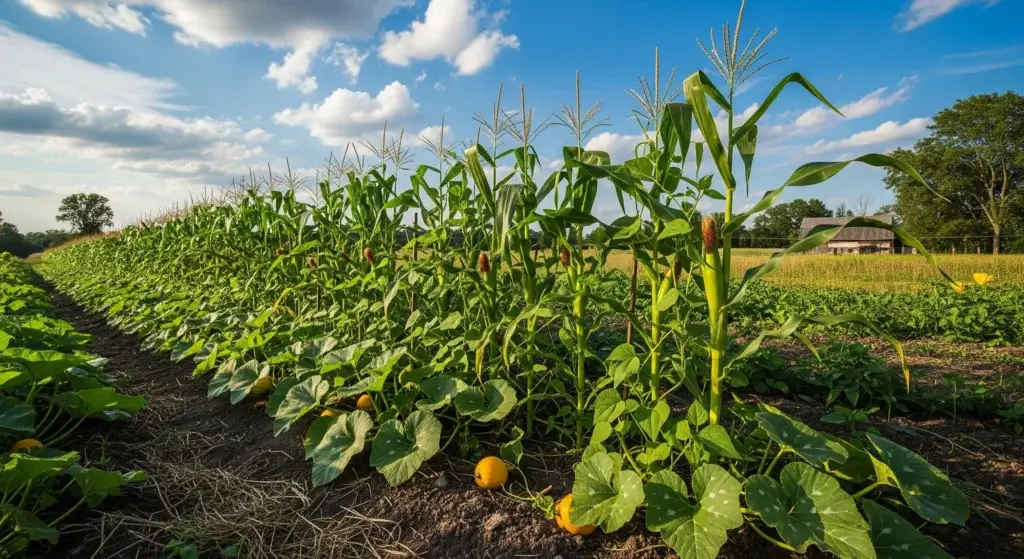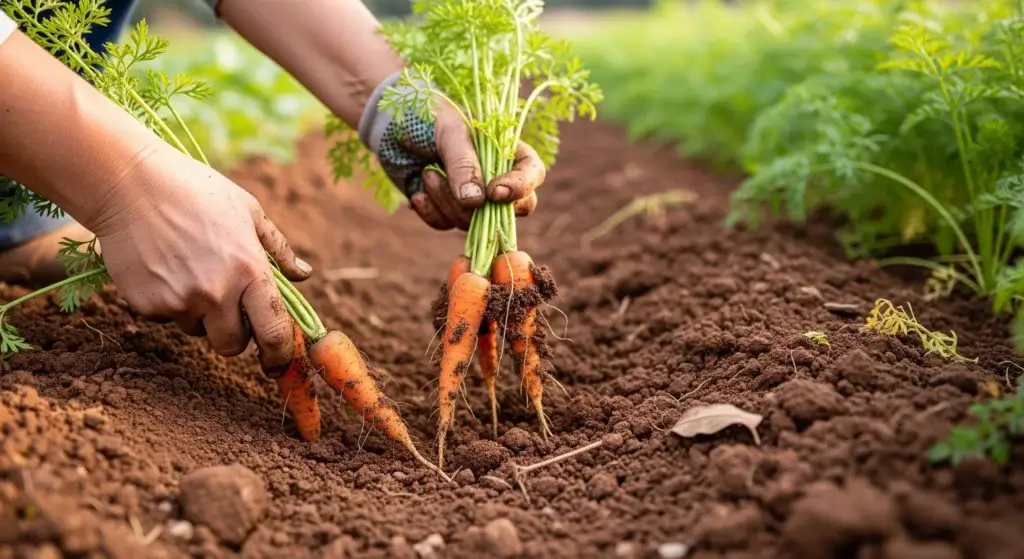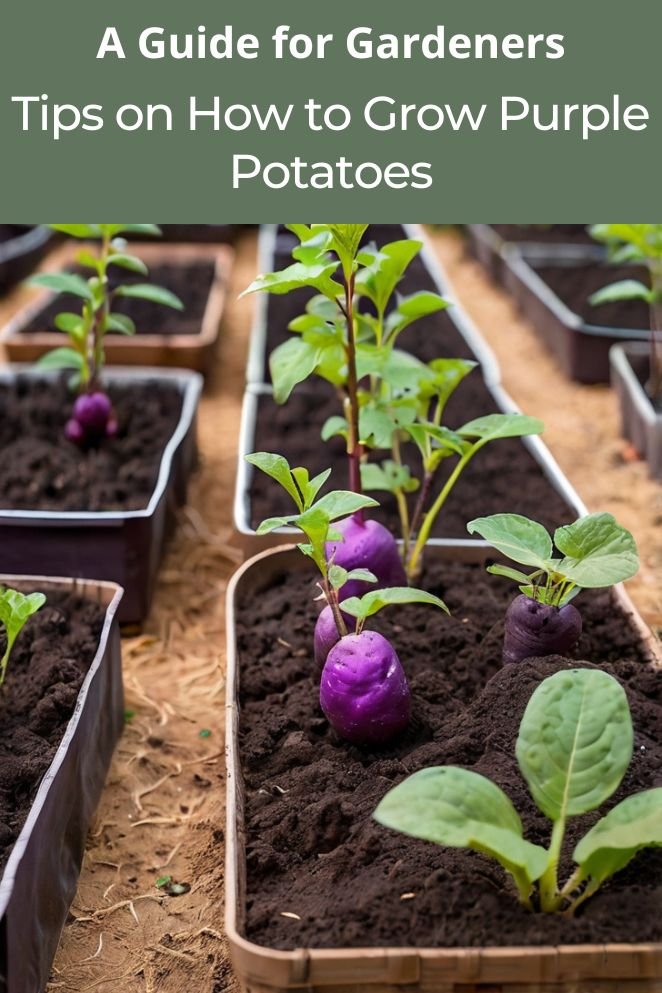
Purple potatoes are not only a feast for the eyes but also a powerhouse of nutrients.
Rich in antioxidants, particularly anthocyanins, which give them their deep purple hue, these potatoes are a healthy alternative to the more common white or yellow varieties.
Whether you’re an experienced gardener or a beginner, growing purple potatoes can be a fun and satisfying project.
In this guide, we’ll cover everything you need to know to grow your own purple potatoes, ensuring a successful and abundant harvest.
Choosing the Right Variety
Before you start planting, it’s important to choose the right variety of purple potatoes for your garden.
There are several types available, each with its own characteristics:
- Purple majesty: This variety is known for its deep purple skin and flesh. It’s an excellent choice for roasting and mashing, and it has a slightly nutty flavor.
- Purple Peruvian: A fingerling variety, Purple Peruvian has a waxy texture and is perfect for salads and roasting. The flesh is a vibrant purple, which holds up well during cooking.
- All blue: Despite its name, All Blue potatoes have a rich purple color. They are versatile and can be used in a variety of dishes, from baking to boiling.
- Vitelotte: This heirloom variety is popular in Europe and is prized for its deep purple flesh and unique flavor.
When selecting a variety, consider your climate, soil type, and intended use.
Some varieties are better suited to certain growing conditions, so it’s important to do a little research or consult with your local nursery.
Soil Preparation
Proper soil preparation is key to growing healthy, productive purple potatoes.
Here’s how to get your soil ready:
- Read also: The Ultimate Guide to Companion Plant for Luscious Potatoes
- Read also: The Ultimate Guide to Hilling Potatoes in Containers
Soil type
Purple potatoes grow best in well-drained, loose soil that is rich in organic matter.
Sandy loam is ideal because it allows for good drainage and root development.
If you don’t have sandy loam, you can use raised beds or containers with a high-quality potting mix.
These options help create a similar environment where your potatoes can thrive.
pH level
Potatoes prefer slightly acidic soil, with a pH between 5.0 and 6.5.
You can check your soil’s pH with a simple testing kit from a garden center.
If your soil is too alkaline (above 6.5), you can lower the pH by adding organic matter like compost or using sulfur.
This adjustment helps the potatoes absorb nutrients more effectively.
Fertilization
Before planting, mix compost or well-rotted manure into the soil.
These organic materials provide essential nutrients that potatoes need to grow.
Avoid using fertilizers that are high in nitrogen, as they can lead to excessive leaf growth rather than healthy tuber development.
Tilling
Tilling the soil to a depth of about 8-12 inches is important.
This process loosens the soil, making it easier for the potato tubers to expand as they grow.
Well-tilled soil helps create a good environment for strong root development and tuber formation.
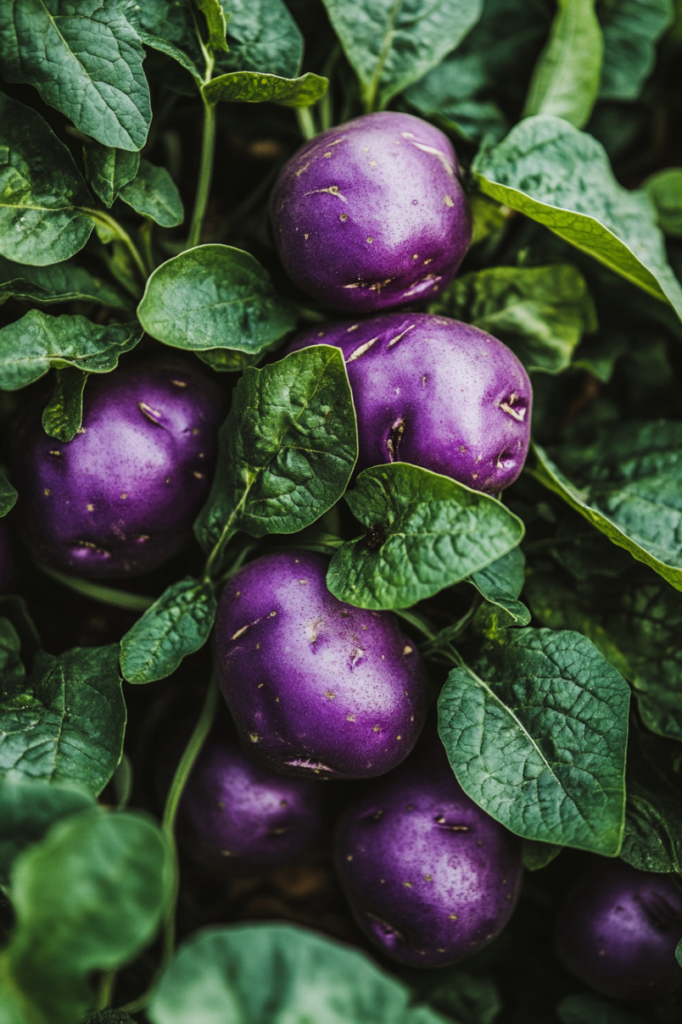
Planting Purple Potatoes
Once your soil is prepared, it’s time to plant your purple potatoes.
Here’s how to do it:
Seed potatoes
Use certified disease-free seed potatoes to ensure a healthy crop.
Cut the potatoes into pieces, making sure each piece has at least one or two “eyes” (the small, sproutable buds).
Allow the cut pieces to dry for a day or two before planting. This drying period helps prevent rot and ensures better growth.
Planting depth and spacing
Plant the potato pieces about 4 inches deep in the soil.
Space the pieces 12 inches apart in rows that are 24-36 inches apart.
This spacing gives each plant enough room to grow and develop tubers without crowding.
Mounding
As the potato plants grow, you’ll need to mound soil around their bases.
This means piling additional soil around the plants as they get taller.
Mounding helps keep the tubers covered and prevents them from being exposed to sunlight, which can cause them to turn green and become inedible.
It also promotes the growth of more tubers.
Watering and Fertilizing
Proper watering and fertilization are crucial for growing healthy purple potatoes.
Here’s what you need to know:
Watering
Potatoes need consistent moisture, especially during tuber formation.
Water deeply once or twice a week, depending on rainfall and soil type.
Avoid overwatering, as soggy soil can lead to rot and other issues.
Mulching with straw or grass clippings can help retain soil moisture and keep weeds at bay.
Fertilizing
After the plants have emerged, you can apply a balanced fertilizer, such as 10-10-10, to encourage growth.
Be careful not to over-fertilize, as too much nitrogen can reduce tuber production.
A second application of fertilizer may be applied mid-season, just before the plants start flowering.
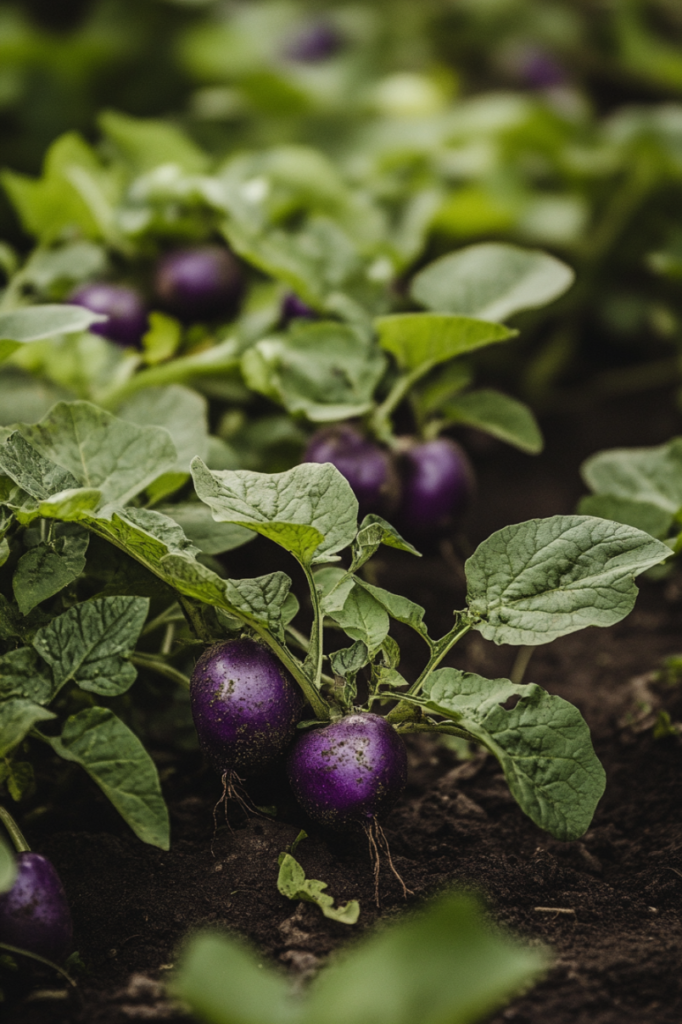
Pest and Disease Management
Like all crops, purple potatoes can be affected by pests and diseases.
Here’s how to keep your plants healthy:
Common Pests
Colorado potato beetles
These beetles are a significant threat to potato plants.
They can be hand-picked from plants, and their larvae can also be removed.
If the infestation is severe, using organic insecticides or introducing beneficial insects like ladybugs, which prey on beetles, can help keep the problem under control.
Aphids
These small insects suck the sap from plants, weakening them and potentially spreading diseases.
They can be managed by spraying plants with insecticidal soap, introducing natural predators like ladybugs, or using neem oil to deter them.
Wireworms
These pests are larvae of click beetles and can damage tubers by feeding on them.
To control wireworms, practice crop rotation, avoid planting potatoes in the same spot each year, and use traps or organic methods to reduce their numbers.
Diseases
Late blight
This fungal disease causes dark, water-soaked spots on leaves and stems, which can lead to rotting tubers.
To prevent late blight, avoid overhead watering, improve air circulation around plants, and remove any infected plant material promptly.
Early blight
Early blight appears as dark spots with concentric rings on leaves, leading to leaf drop and reduced plant vigor.
Practice crop rotation and remove infected leaves to manage early blight.
Using resistant potato varieties can also help.
Scab
Scab causes rough, corky patches on the surface of potatoes. It thrives in dry, alkaline soil.
To prevent scab, avoid over-fertilizing with high-nitrogen fertilizers, maintain slightly acidic soil conditions, and practice proper irrigation techniques.

Harvesting Your Purple Potatoes
Knowing when and how to harvest your purple potatoes is key to enjoying a bountiful crop.
Here’s what to do:
When to harvest
Purple potatoes are typically ready for harvest 90-120 days after planting, depending on the variety.
You’ll notice the plants begin to die back, with the leaves turning yellow, signaling that it’s time to harvest.
You can also check the tuber size by gently digging around the base of the plant to see if the potatoes have reached a good size.
How to harvest
Use a garden fork or spade to carefully lift the plants out of the ground.
Be gentle to avoid bruising or cutting the tubers.
After lifting the plants, brush off excess soil but avoid washing the potatoes until you’re ready to use them.
Washing too early can shorten their storage life.
Curing and storage
After harvesting, cure your potatoes to prepare them for storage.
Place them in a cool, dark, well-ventilated area for about a week or two.
Curing helps toughen the skins and reduces the risk of damage during storage.
Once cured, store the potatoes in a cool, dark place with good airflow, like a basement or root cellar.

- Read also: Tips and Tricks: Essential Tips for Hilling Potatoes in Grow Bags
- Read also: When to Fertilize Potatoes: A Comprehensive Guide for Optimal Growth
Final Thoughts
Growing purple potatoes at home can be a rewarding experience, providing you with a unique and nutritious addition to your meals.
By choosing the right variety, preparing your soil properly, and following the best practices for planting, watering, and pest control, you can enjoy a successful harvest.
Whether you’re a seasoned gardener or a beginner, purple potatoes are a fun and easy crop to grow, and they’ll add a splash of color and flavor to your garden and kitchen.
FAQs
Most purple potato varieties take between 90-120 days from planting to harvest, depending on the variety and growing conditions.
Yes, purple potatoes can be successfully grown in containers. Just make sure the container is large enough to allow for tuber development and use a well-draining potting mix.
To prevent greening, ensure that the tubers are fully covered with soil or mulch during the growing season. Green potatoes contain solanine, which can be toxic.
Purple potatoes are rich in antioxidants, particularly anthocyanins, which have been linked to various health benefits, including improved heart health and reduced inflammation.

